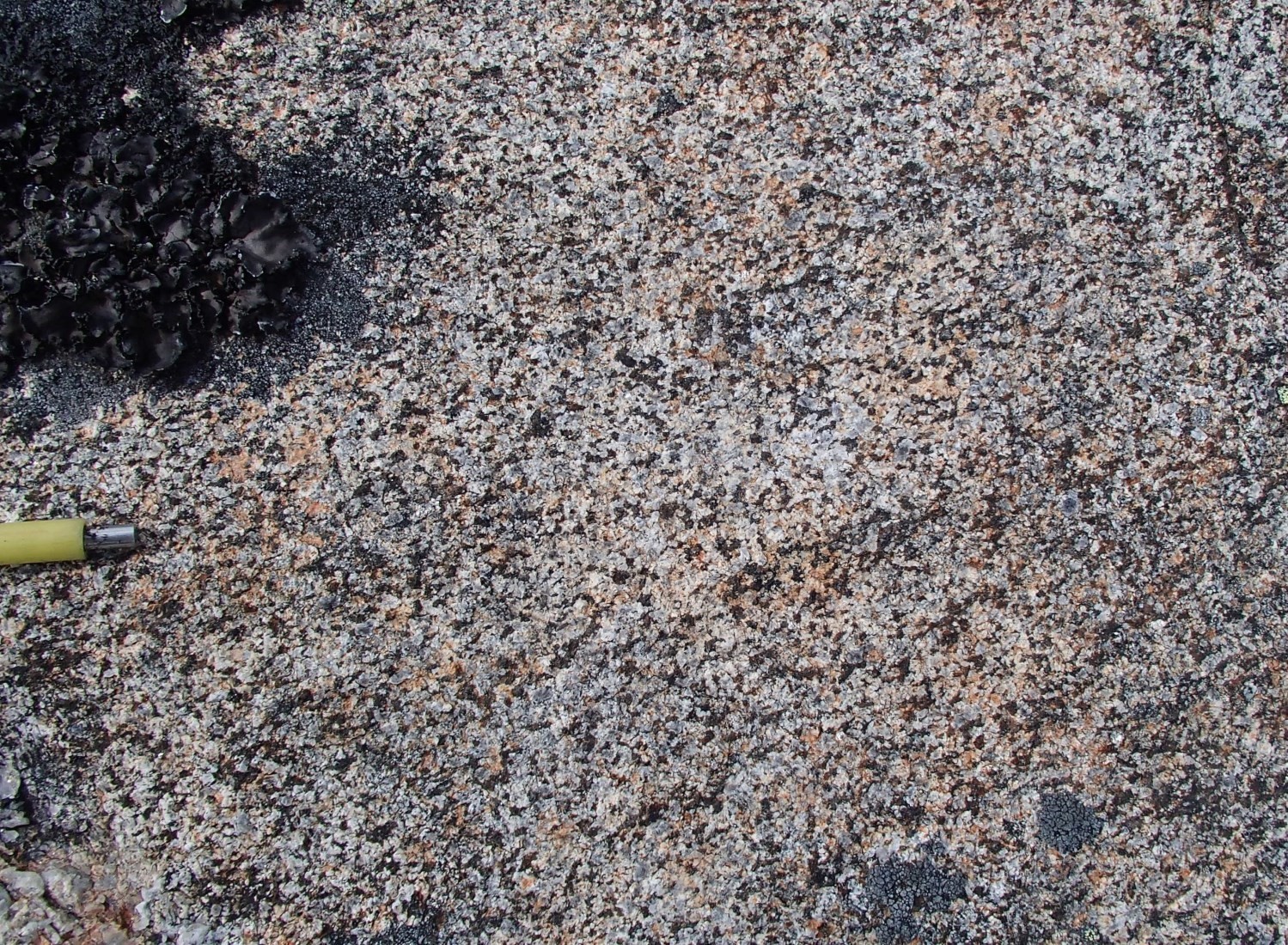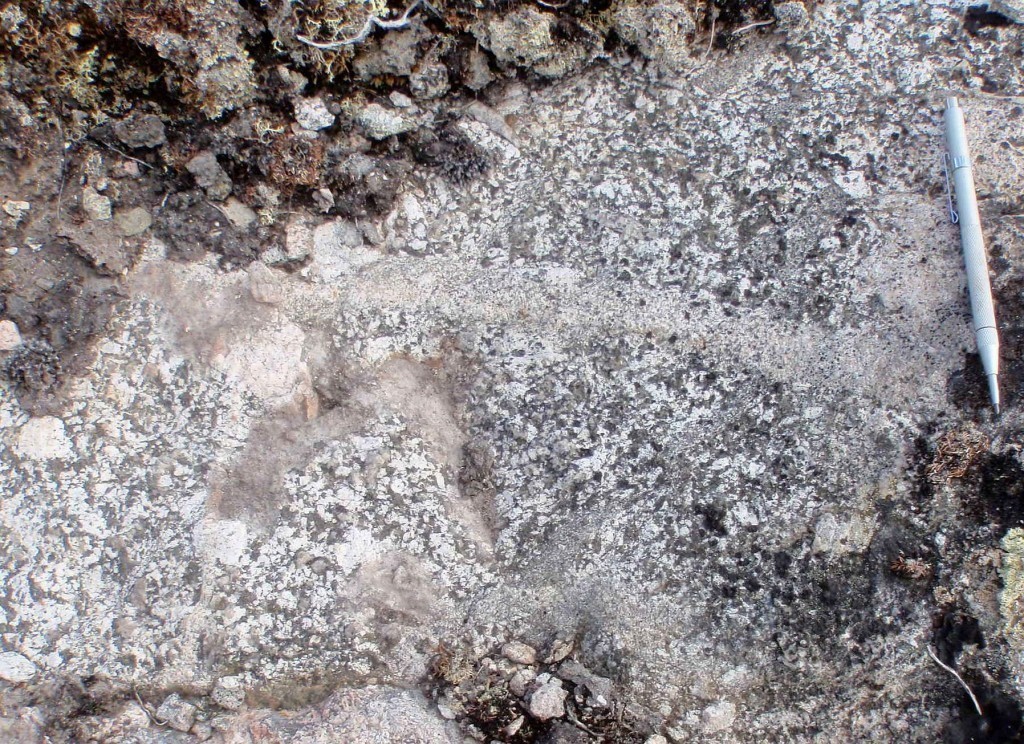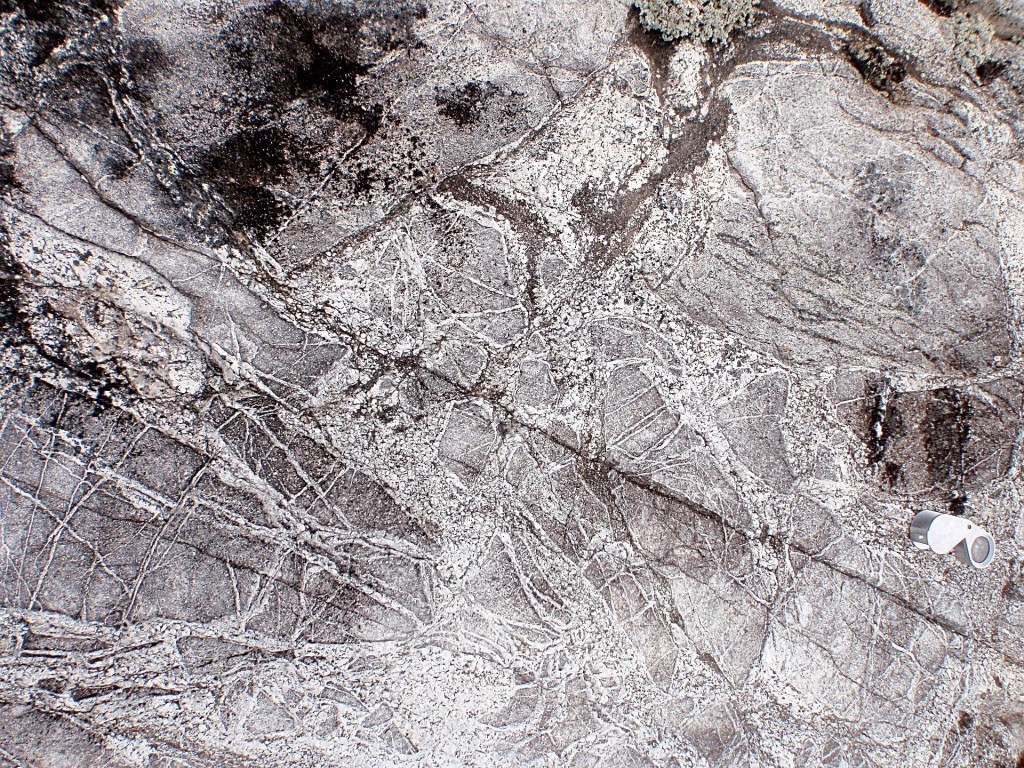
| Author: | Danis, 1991 |
| Age: | Paleoproterozoic |
| Stratotype: | None |
| Type area: | Mina Lake (NTS sheets 23P14 and 23A03) and Raude Lake (sheet 23P02) area |
| Geological province: | Churchill Province |
| Geological subdivision: | George Lithotectonic Domain |
| Lithology: | Orthopyroxene-bearing mafic to felsic intrusive rocks |
| Category: | Lithodemic |
| Rank: | Suite |
| Status: | Formal |
| Use: | Active |
- De Pas Supersuite
- De Pas Granitic Suite
- De Pas Charnockitic Suite
Background
The De Pas Charnockitic Suite was defined by Danis (1991) and divided into informal units based on the dominant lithology. This suite makes with the De Pas Granitic Suite, the De Pas Supersuite. The latter is a polyphase syntectonic intrusion extending over 440 km in a N-S to NNW-SSE direction within the George Lithotectonic Domain (Charette et al., 2018).
A regional compilation by the Ministère’s geologists in 2003 (MNRF, 2010a-c) subdivided the De Pas Charnockitic Suite into three informal units (pPcde2 to pPcde4). These were abandoned by Hammouche et al. (2011) who defined three informal units (pPcde5 to pPcde7). These were used as part of the 1:250 000 mapping work done between 2011 and 2016. The nomenclature used to describe the De Pas Charnockitic Suite was standardized as part of the regional synthesis of the entire Southeastern Churchill Province (SECP; Lafrance et al., 2018). Three informal units (pPcde1 to pPcde3) have then been defined. These changes are described in the table below.
| Revised Units and Subunits | Previous Units and Subunits | Reference(s) |
|---|---|---|
| pPcde1 | pPcde6 | MRNF, 2010a, b; Hammouche et al., 2011; Charette et al., 2016 |
| pPcde2 | pPcde5a | Lafrance et al., 2016; Charette et al., 2016 |
| pPcde2 | MRNF, 2010b, c | |
| F6c | Danis, 1988, 1991; Bourque, 1991 | |
| pPcde3 | MRNF, 2010b, c | |
| F6b | Danis, 1988, 1991; Bourque, 1991 | |
| pPcde2a | pPcde5 | MRNF, 2010a, b; Hammouche et al., 2011; Lafrance et al., 2015, 2016; Charette et al., 2016 |
| pPcde4 | MRNF, 2010b, c | |
| F6a | Danis, 1988, 1991; Bourque, 1991 | |
| pPcde2b | pPcde6a | Hammouche et al., 2011 |
| pPcde3 | pPcde7 | MRNF, 2010a, b; Hammouche et al., 2011; Lafrance et al., 2015, 2016; Charette et al., 2016 |
Description
The De Pas Charnockitic Suite groups orthopyroxene intrusive rocks of the De Pas Supersuite. Rocks are massive to slightly foliated, but the degree of deformation increases towards the western edge of the unit in contact with the Knox Complex. The foliation then becomes very strong and the rock acquires a gneissic appearance. The sequence consists mainly of felsic and intermediate lithologies characterized by very high lithological and structural heterogeneity, even at the metric scale. It is subdivided into three units: 1) orthopyroxene diorite, jotunite and mangerite (pPcde1); 2) opdalite and enderbite (pPcde2); and 3) gabbronorite, gabbro and leuconorite (pPcde3).
De Pas Charnockitic Suite 1 (pPcde1): Hypersthene Diorite, Jotunite and Mangerite
Unit pPcde1 consists mainly of lithologies of intermediate composition including hypersthene diorite, jotunite (hypersthene quartz monzodiorite) and mangerite (orthopyroxene monzonite). It also contains a small proportion of orthopyroxene felsic rocks identical to those of unit pPcde2, as well as enderbite (orthopyroxene tonalite). Unit pPcde1 intermediate rocks are medium grained, locally coarse grained. In places, they have a massive to slightly foliated appearance, whereas in other areas, foliation and banding are visible. Mangerite is locally K-feldspar porphyritic (phenocrystals 3-4 cm, exceptionally 10 cm long). Silicate minerals are euhedral, locally subhedral, and the myrmekitic texture is common. Ferromagnesian minerals are distributed homogeneously, in small clusters or laminae and account for 5% to 20% of the rock’s mode. Orthopyroxene, biotite and hornblende, accompanied in places by clinopyroxene and tremolite, are the main ferromagnesian minerals. Garnet has been observed locally in hypersthene diorite. Alteration results in the development of damourite from plagioclase, as well as uralite and epidote at the expense of pyroxenes.
Light green paragneiss enclaves were observed locally. Paragneiss is composed of quartz, plagioclase, biotite, clinopyroxene and garnet in granoblastic clusters. In the Bonaventure Lake area (Hammouche et al., 2011), microscopic observations also indicate the presence of corundum and hercynite.
De Pas Charnockitic Suite 2 (pPcde2): Opdalite, Enderbite and Jotunite
Unit pPcde2 forms intrusive masses associated with strong positive aeromagnetic anomalies. In the Bonaventure Lake area (Hammouche et al., 2011), this unit consists mainly of felsic rocks, namely opdalite (orthopyroxene granodiorite) and enderbite, as well as minor amounts of charnockite. There are also layers of mangerite, jotunite and hypersthene diorite. In the Henrietta Lake area (Lafrance et al., 2015), most of this unit’s rocks alternate between opdalite and jotunite (12-25% quartz), which are locally associated with mangerite. Unit pPcde2 rocks are medium to coarse grained, greenish to brown sugar, and massive to slightly foliated. In some areas, they are affected by regional faults and are then transformed into gneiss or mylonite. Ferromagnesian minerals (dark brown to reddish biotite, orthopyroxene, green hornblende and clinopyroxene) form clusters that account for 10 to 20% of the rock. Accessory minerals associated with these clusters include apatite, opaque minerals (especially magnetite) and, more locally, sphene, allanite, epidote and muscovite.
Alteration results in feldspar sericitization and replacement of orthopyroxene by epidote and actinolite. The rock is locally intruded by pink granite dykes similar to that of the De Pas Granitic Suite pPdep4 unit. These dykes contain up to 5% centimetric to decimetric enclaves of fine-grained and granoblastic diorite. Subrounded centimetric to metric enclaves stretched in foliation and metric layers of granoblastic hypersthene diorite, possibly associated with the Knox Complex (ApPgkx1), are observed in felsic intrusive rocks of the pPcde2 unit, particularly in the SW portion of the De Pas Supersuite, near the contact with the Knox Complex.
De Pas Charnockitic Suite 2a (pPcde2a): Porphyraceous Opdalite and Jotunite
Unit pPcde2 rocks characterized by a porphyraceous texture were grouped into subunit pPcde2a (other textural and mineralogical characteristics remain the same). In general, these orthopyroxene felsic rocks contain 10 to 25% pink to salmon microcline phenocrystals ranging in size from 1 to 5 cm long to 10 cm locally. There are localized concentrations of phenocrystals (50-80%) possibly representing magmatic layering. In thin sections, magmatic textures are well preserved with myrmekites recrystallization rims around phenocrystals.
De Pas Charnockitic Suite 2b (pPcde2b): Highly Magnetic Opdalite, Jotunite and Mangerite
In the Bonaventure Lake (Hammouche et al., 2011) and Recouet Lake (Danis, 1988) areas, a subunit with higher magnetite content was distinguished (pPcde2b). This feature gives it a very high magnetic susceptibility, allowing it to be easily circumscribed on aeromagnetic maps. Rocks of this subunit also contain K-feldspar phenocrystals. Ferromagnesian minerals (brown-red biotite, green hornblende, clinopyroxene and orthopyroxene) are present in slightly greater amounts than elsewhere and represent up to 30% of the rock.
De Pas Charnockitic Suite 3 (pPcde3): Leucogabbro, Leucogabbronorite and Anorthosite
Unit pPcde3 forms a few long, mafic intrusive masses <1 km wide by 1 to 8 km long. This unit, associated with strong positive magnetic anomalies, consists of leucocratic gabbro and gabbronorite, as well as anorthosite and quartz anorthosite. The rock is medium grained, massive to foliated, and on outcrops, has several intrusive phases in diffuse contact. Gabbro and gabbronorite are dark brown to dark green. They contain 15 to 25% ferromagnesian minerals forming clusters heterogeneously distributed around granoblastic plagioclase crystals. These minerals include green to brown hornblende, clinopyroxene, brown to red biotite, magnetite and, in the case of gabbronorite, orthopyroxene. Hornblende replaces pyroxenes. Sericite and epidote are also observed in places.
Anorthosite is locally brecciated by leucocratic gabbro to form a mesh texture. It contains up to 10% quartz and 2-8% ferromagnesian minerals identical to those observed in gabbro. It also contains some apatite and sphene.
Thickness and Distribution
The De Pas Charnockitic Suite is located mainly in the southern third of the De Pas Supersuite, where it is 10 km to 22 km wide. It has been recognized in the Recouet Lake (Danis, 1988), Mina Lake (Bourque, 1991), Raude Lake (Danis, 1991), Bonaventure Lake (Hammouche et al., 2011), Henrietta Lake (Lafrance et al., 2015), Brisson Lake (Lafrance et al., 2016) and Jeannin Lake (Charette et al., 2016) areas. De Pas Supersuite units are mostly located inside the George Lithotectonic Domain. However, they were also observed inside the Baleine Lithotectonic Domain, located just to the west. Rocks of units pPcde2 and pPcde2a are by far the dominant lithologies, covering 872 km2 and 1113 km2 respectively. Units and subunits pPcde1 (251 km2), pPcde2b (194 km2) and pPcde3 (52 km2) cover smaller areas.
Dating
Historical ages indicate that intrusions of the De Pas Charnockitic Suite were emplaced between 1840 Ma and 1811 Ma (Bowring in van der Leeden et al., 1990; Krogh, 1986; James et al., 1996). The age of 1837 Ma obtained in a mylonitic opdalite sample (outcrop 2009-JG-1108) located on the western edge of the De Pas Charnockitic Suite (David et al., 2011) allowed Hammouche et al. (2011) to reassign this zone to the De Pas rather than to the granulitic gneiss unit located just west (Knox Complex).
| Unit | Sample Number | Isotopic System | Mineral | Crystallization Age (Ma) | (+) | (-) | Reference(s) |
| pPcde2 | 2009-JG-1108A | U-Pb | Zircon | 1837. 3 | 4.5 | 4.5 | David et al., 2011 |
| pPcde2a | – |
U-Pb |
Zircon | 1840 | – | – | Bowring, in van der Leeden et al., 1990 |
| pPcde2a | – | U-Pb | Zircon | 1811 | 3 | 3 | Krogh, 1986 |
| pPcde2a | – |
U-Pb |
Zircon | 1831 | 5 | 5 | James et al., 1996 |
Stratigraphic Relationship(s)
Units of the De Pas Charnockitic Suite cut gneiss of the Saint-Sauveur Complex. They also contain several enclaves of these gneiss, as well as enclaves of migmatite from the Guesnier Complex (nApPges1), diorite, gabbro and volcano-sedimentary rocks of the Tunulic Complex. Field relationships indicate that the contact with the De Pas Granitic Suite is gradual.
Paleontology
Does not apply.
References
| Author(s) | Title | Year of Publication | Hyperlink (EXAMINE or Other) |
|---|---|---|---|
| MRNF | CARTE(S) GÉOLOGIQUE(S) DU SIGEOM – feuillet 23I. CG SIGEOM23I, 8 plans. | 2010a | CG SIGEOM23I |
| MRNF | CARTE(S) GÉOLOGIQUE(S) DU SIGEOM – feuillet 23P. CG SIGEOM23P, 16 plans. | 2010b | CG SIGEOM23P |
| MRNF | CARTE(S) GÉOLOGIQUE(S) DU SIGEOM – feuillet 24A. CG SIGEOM24A, 1 plan. | 2010c | CG SIGEOM24A |
| BOURQUE, Y. | Géologie de la région du lac Mina (Territoire-du-Nouveau-Québec). Ministère de l’Énergie et des Ressources, Québec; ET 88-08, 48 pages, 4 plans. | 1991 | ET 88-08 |
| CHARETTE, B. – LAFRANCE, I. – VANIER, M.-A. | George Lithotectonic Domain, Southeastern Churchill Province, Nunavik, Quebec, Canada: Geological Synthesis. Ministère de l’Énergie et des Ressources naturelles, Québec. BG 2018-11. | 2018 | BG 2018-11 |
| CHARETTE, B. – LAFRANCE, I. – MATHIEU, G. | Géologie de la région du lac Jeannin (SNRC 24B), Québec, Canada. Ministère de l’Énergie et des Ressources naturelles, Québec. BG 2015-01. | 2016 | |
| DANIS, D. | Géologie de la région du lac Recouet (Territoire-du-Nouveau-Québec). Ministère de l’Énergie et des Ressources, Québec; ET 86-11, 60 pages, 4 plans. | 1988 | ET 86-11 |
| DANIS, D. | Géologie de la région du lac Raude (Territoire-du-Nouveau-Québec). Ministère de l’Énergie et des Ressources, Québec; ET 88-10, 72 pages, 5 plans. | 1991 | ET 88-10 |
| DAVID, J. – McNICOLL, V. – SIMARD, M. – BANDYAYERA, D. – HAMMOUCHE, H. – GOUTIER, J. – PILOTE, P. – RHÉAUME, P. – LECLERC, F. – DION, C. | Datation U-Pb effectuées dans les provinces du Supérieur et de Churchill en 2009-2010. Ministère des Ressources naturelles et de la Faune, Québec; RP 2011-02, 37 pages. | 2011 | RP 2011-02 |
| DUNPHY, J.M. – SKULSKI, T. | Petrological zonation across the De Pas Batholith: a tilted section through a continental arc? In Eastern Canadian Shield Onshore–Offshore (ECSOOT) Transect Meeting 1996 (Wardle R.J. and Hall, J., editors). The University of British Columbia, Lithoprobe Secretariat; Report 57, pages 44-58. | 1996 | – |
| HAMMOUCHE, H. – LEGOUIX, C. – GOUTIER, J. – DION, C. – PETRELLA, L | Géologie de la région du lac Bonaventure. Ministère des Ressources naturelles et de la Faune, Québec; RG 2011-03, 37 pages, 1 plan. | 2011 | RG 2011-03 |
| JAMES, D.T. – DUNNING, G.R. | U-Pb geochronological constraints for Paleoproterozoic evolution of the Core Zone, southeastern Churchill Province, northeastern Laurentia. Precambrian Research; volume 103, pages 31-54. | 2000 | Source |
| JAMES, D.T. – CONNELLY, J.N. – WASTENEYS, H.A. – KILFOIL, G.J. | Paleoproterozoic lithotectonic divisions of the southeastern Churchill Province, western Labrador. Canadian Journal of Earth Sciences; volume 33, pages 216-230. | 1996 | Source |
| KROGH, T.E. | Report to Newfoundland Department of Mines and Energy on isotopic dating results from the 1985-1986 geological research agreement. Newfoundland Department of Mines and Energy, Mineral Development Division; Open File Report LAB 707. | 1986 | – |
| ISNARD, H. – PARENT, M. – BARDOUX, M. – DAVID, J. – GARIÉPY, C. – STEVENSON, R.K. | U-Pb, Sm–Nd and Pb–Pb isotope geochemistry of the high-grade gneiss assemblages along the southern shore of Ungava Bay. In Eastern Canadian Shield Onshore–Offshore (ECSOOT), Transect Meeting, 1998 (Wardle R.J. and Hall, J., editors). The University of British Columbia, Lithoprobe Secretariat; Report 68, pages 67-77. | 1998 | – |
| LAFRANCE, I. – CHARETTE, B. – VANIER, M.-A. | Southeastern Churchill Province, Nunavik, Quebec, Canada: Geological Synthesis. Ministère de l’Énergie et des Ressources naturelles, Québec. Preliminary BG. | 2018 | Bulletin géologiQUE |
| LAFRANCE, I. – BANDYAYERA, D. – CHARETTE, B. – BILODEAU, C. – DAVID. J. | Géologie de la région du lac Brisson (SNRC 24A). Ministère de l’Énergie et des Ressources naturelles, Québec; RG 2015-05, 61 pages. | 2016 | RG 2015-05 |
| LAFRANCE, I. – BANDYAYERA, D. – BILODEAU, C. | Géologie de la région du lac Henrietta (SNRC 24H). Ministère des Ressources naturelles, Québec; RG 2015-01, 62 pages. | 2015 | RG 2015-01 |
| VAN DER LEEDEN, J. – BELANGER, M. – DANIS, D. – GIRARD, R. – MARTELAIN, J. | Lithotectonic domains in the high-grade terrain east of the Labrador Trough (Quebec). In The Early Proterozoic Trans-Hudson Orogen. Edited by J.F. Lewry and M.R. Stauffer. Geological Association of Canada; Special Paper 37, pages 371-386. | 1990 | Source |






